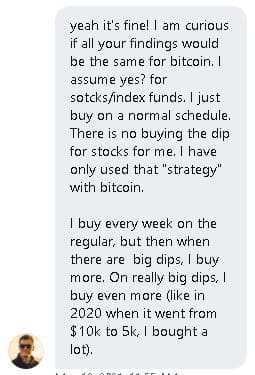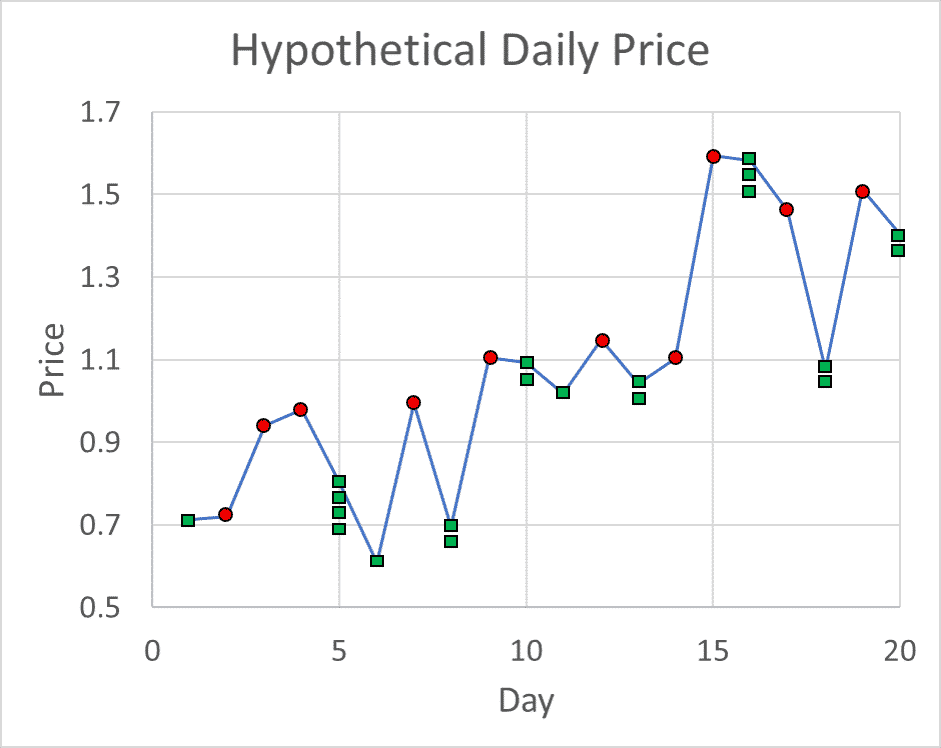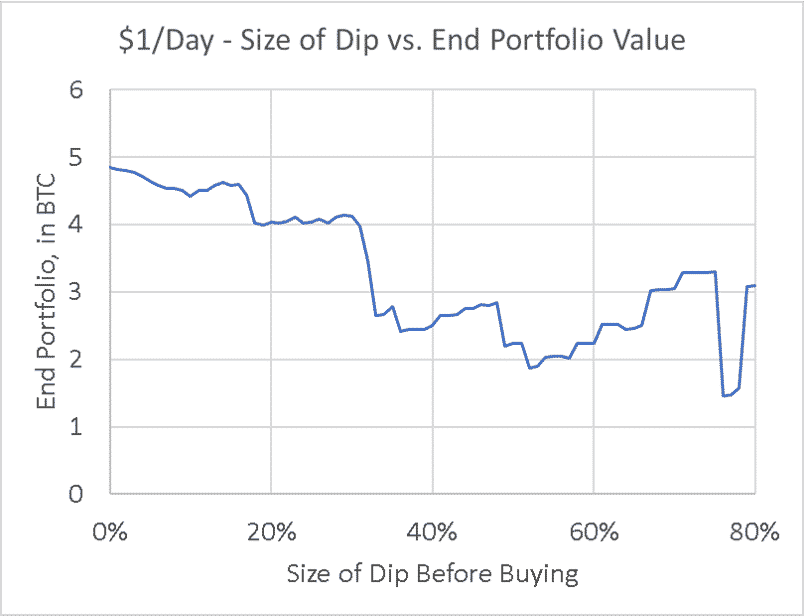We’ve covered that “buying the dip” is a sub-optimal strategy for purchasing stocks. Here’s the rationale that we discussed two weeks ago. But a few readers asked if the same logic applied to Bitcoin…


Bitcoin is more volatile than stocks. It’s constantly bouncing up and down. So perhaps a “buy the dip” strategy would have more opportunity to work effectively?
And then there’s the issue of intrinsic value vs. extrinsic value.
Bitcoin, like gold, only appreciates in value based on supply and demand. The value is extrinsic, based on the demand that investors have for it. Stocks, however, produce cash flow in the form of dividends. This cash flow gives stocks intrinsic value. I’d want that cash flow even if nobody else on Earth wanted it.
Waiting for a dip before buying stocks leads to a delay in collecting those dividends. You’re missing out on important value. But waiting to invest in Bitcoin bears no such penalty. This important difference could mean that waiting for the dip is more effective for Bitcoin than for stocks.
Note: since Bitcoin has no intrinsic value, many investors find it to be a dubious long-term investment.
Here’s a recent post on the potential Bitcoin bubble.
And here’s one explaining the inner workings of Bitcoin in simple terms.
Since we can’t be certain what the future holds, our best bet is to back-test various “buy the dip” strategies against historic Bitcoin price data. If someone had used these strategies before, would it have worked?
Comparison: Dollar Cost Average vs. Buy the Dip
What should we compare “buying the dip” against? Traditionally, investors have used dollar cost averaging (DCA) as a comparison. DCA is a set contribution amount at a pre-determined frequency, regardless of whether the asset price in question is high or low. It’s how I invest
The foundational idea behind DCA is that asset values are difficult to predict (e.g., “don’t time the market!”). As such, you’re better off determining a purchasing frequency irrespective of an asset’s price. For example, I buy index funds every two weeks via my 401(k) and once per month via my Roth IRA.
DCA into bitcoin will act as the baseline strategy for today’s analysis.
True DCA
One set of analyses I’ll run today assumes that our hypothetical investor invests $1 per day into Bitcoin, regardless of the price.
Set amount = $1, set frequency = every day.
Dollar Bitcoin Cost Averaging
By request, I’ll also look at a form of Bitcoin cost averaging. Rather than spend $1 per day, I’ll look at buying 1/100 of a Bitcoin per day. I’ll call this BCA.
Date Range
I’ve found Bitcoin pricing data back to July 2010, when one Bitcoin was trading for fractions of a penny. However, many sources start tracking Bitcoin’s price data in 2013 (e.g. Coindesk and Coingecko).
I’ve taken their lead and start today’s analysis in May 2013.
Executing ‘Buy The Dip’
While our DCA and BCA strategies purchase Bitcoin everyday, what’s the logic behind “buying the dip?”
It’s quite straightforward. We assume that our hypothetical investor saves his DCA/BCA dollars unless the market has dipped from a previous high. It looks something like this:

Each green square represents a buy. Each red circle represents a day we wait for a future dip.
Day 5 looks smart. We didn’t buy on Days 2-4 (prices = 0.72, 0.94, 0.98), saving those three days’ money until Day 5 (price = 0.81). I’ll run the math for you: we gain ~5% extra of our hypothetical asset by waiting for this dip. Nice!
But what about Day 16? We didn’t buy on Days 14 and 15 (prices = 1.10, 1.59) but did buy at 1.58. The math here is that we lose ~12% of what we would have had using a simple dollar cost averaging. Waiting for this dip hurt us.
The question, then, is whether historical data shows more “good” instances like Day 5 or “bad” instances like Day 16.
Bigger Dips
Do we buy every dip? Or should we only wait for big dips? I could execute a rule where small dips (like Day 16, above) don’t matter. Only the big dips matter—such as Day 18.
But whatever we choose, we have to set a rule and stick to it. When executing a strategy in real-time, we do not have the luxury of peering into the future to determine if current prices are good or bad in comparison. We cannot “cherry-pick” which dips we buy and which we do not.
Here’s a great example. If we set a big dip rule, then we would not buy between Days 9-14, above. The market is too flat, the dips too small. The market takes off on Day 15 only to crash back on Day 18. Hooray! We’ve hit our big crash.
But the price on Day 18 is higher than it was on Day 11 and Day 13. Skipping the small crashes did not help in this instance. The market gained too much before the eventual big crash.
This phenomenon happens all the time, especially in markets where assets generally increase in price. We wait for a big crash that never quite comes. Why doesn’t it come? Because the market is increasing, “running away” from us. This is why “timing the market” is frowned upon.
Enough preamble. Let’s get to some actual Bitcoin “buy the dip” results.
Enjoying this article? Subscribe below to get new articles emailed straight to your inbox
Bitcoin “Buy The Dip” Results
First, let’s cover our baselines—the DCA and the BCA case.
The DCA case assumed our investor spent $1 on Bitcoin every day from May 1, 2013 until May 23, 2021 (when I grabbed the latest data).
The BCA case assumed our investor bought 1/100 of a Bitcoin every day from May 1, 2013 until May 23, 2021. The results of these two baseline cases are:
| Case | US Dollars Spent | Total Bitcoin Owned |
| DCA Baseline – $1/Day | $2943 | 4.859 |
| BCA Baseline – 0.01 BTC/Day | $184,580 | 29.44 |
Our baseline is set. If “buy the dip” works, we hope to get more Bitcoin for our buck. So let’s take a look at Rule 1: Don’t Buy Until There’s a Dip (of Any Size). If today’s price is equal to or higher than the previous day, we save today’s cash. We keep saving cash until the market eventually dips—when today’s price is less than yesterday’s.
| Case | US Dollars Spent | Total Bitcoin Owned |
| DCA Baseline – $1/Day | $2943 | 4.859 |
| BCA Baseline – 0.01 BTC/Day | $184,580 | 29.44 |
| $1/Day – Any Dip (Rule 1) | $2943 | 4.844 |
| 0.01 BTC/Day – Any Dip (Rule 1) | $184,580 | 29.36 |
What do we see? Buying the dip hurts our portfolio, albeit by a very small amount. There are too many individual scenarios where the market runs away from us by a larger amount than the subsequent crash (just like Days 11-18 in the chart above).
But what if we waited for bigger dips?
Waiting for Bigger Dips
In our previous stock market analysis, waiting for big dips hurt more than waiting for small dips. Do we see the same thing here?
First, let’s look at 5% dips…Rule 2: Don’t Buy Until There’s a Dip Greater Than 5% from the Most Recent High Price.
| Case | US Dollars Spent | Total Bitcoin Owned |
| DCA Baseline – $1/Day | $2943 | 4.859 |
| BCA Baseline – 0.01 BTC/Day | $184,580 | 29.44 |
| $1/Day – Any Dip (Rule 1) | $2943 | 4.844 |
| 0.01 BTC/Day – Any Dip (Rule 1) | $184,580 | 29.36 |
| $1/Day – >5% Dips (Rule 2) | $2943 | 4.639 |
| 0.01 BTC/Day – >5% Dips (Rule 2) | $184,580 | 28.42 |
More bad news for buying the dip. Waiting for 5% dips produced worse results than waiting for minimal dips. We end up with less Bitcoin than if we had implemented simple DCA or BCA.
Let’s try two more rules: waiting for 10% dips and waiting for 25% dips.
| Case | US Dollars Spent | Total Bitcoin Owned |
| DCA Baseline – $1/Day | $2943 | 4.859 |
| BCA Baseline – 0.01 BTC/Day | $184,580 | 29.44 |
| $1/Day – Any Dip (Rule 1) | $2943 | 4.844 |
| 0.01 BTC/Day – Any Dip (Rule 1) | $184,580 | 29.36 |
| $1/Day – >5% Dips (Rule 2) | $2943 | 4.639 |
| 0.01 BTC/Day – >5% Dips (Rule 2) | $184,580 | 28.42 |
| $1/Day – >10% Dips (Rule 3) | $2943 | 4.42 |
| 0.01 BTC/Day – >10% Dips (Rule 3) | $184,580 | 27.35 |
| $1/Day – >25% Dips (Rule 4) | $2943 | 4.04 |
| 0.01 BTC/Day – >25% Dips (Rule 4) | $184,580 | 27.72 |
More bad news. Buying the dip is still worse than the simple DCA/BCA solution. The medium news that is bigger dips tend to produce worse outcomes, but there are exceptions.
Here’s the full set of “size of dip” vs. end portfolio value.

Why do some larger dips perform better than smaller dips?
It’s randomness. On average, waiting for dips hurts more than it helps. But we saw earlier than some dips can help. Waiting for bigger dips could mean that we skip purchases that hurt us and save money for purchases that help us. Overall, the odds are against us. But randomness in the data sometimes skews in our favor.
Nevertheless, the data is clear: waiting for the dip is worse than dollar cost averaging, and waiting for bigger dips tends to hurt more than it helps.
Who knows what the future will hold. Perhaps this trend will reverse in light of new price data. But with the data we have right now, the evidence is clear: dollar cost averaging works better than buying the dip.
Two More Cases
Friends of the blog David and Roger asked me to look at a couple more scenarios.
David wondered how daily DCA compares to weekly DCA or monthly DCA. How much better is $1 every day vs. $7 once a week or $30ish once a month?
And Roger asked if there are shorter timespans in Bitcoin’s history where “buy the dip” was the optimal strategy.
Starting with the answer to David’s question:
| DCA Frequency | Total Bitcoin Owned |
| Daily | 4.859 |
| Weekly | 4.807 |
| Monthly | 4.793 |
| Quarterly | 4.517 |
| Yearly | 3.599 |
Just like with stocks, this answer suggests that the optimum strategy is to get your money into the market sooner rather than later. Putting in one dollar every day is better than amassing $365 and waiting for the end of the year.
This should make sense. Since we’ve seen that the Bitcoin market tends to rise in price over time, earlier money has a better probability of getting in at a lower price. Of course, the trillion-dollar question is: will this past trend remain consistent in the future?
Roger’s answer is straightforward, too. Just like the stock market, yes, there are time periods when “buying the dip” was better than DCA. The struggle is being able to identify in real-time when you’re in one of those periods.
Waiting for a dip looks great when you’re near a local market peak. But how can you determine in real-time whether the local market peak will continue to swell or is about to burst? Hindsight is 20/20. Driving in the fog is hard.

I can’t tell you whether to invest in Bitcoin or not. But I can tell you that based on historic market data, buying the dip based solely on price is a sub-optimal investing strategy.
Thank you for reading! If you enjoyed this article, join 8000+ subscribers who read my 2-minute weekly email, where I send you links to the smartest financial content I find online every week.
-Jesse
Want to learn more about The Best Interest’s back story? Read here.
Looking for a great personal finance book, podcast, or other recommendation? Check out my favorites.
Was this post worth sharing? Click the buttons below to share!
Hi Jesse, thanks for the follow-up to my question!
Really good article and very clear presentation.
I have to admit, even with all this data staring me in the face, it’s still emotionally hard for me to “believe” that buying the dip is inferior. The mind is crazy sometimes…
I was wondering, could you share what data you are using for the analysis? I’ve gotten motivated to run a few scenarioes myself now, and I would love to do it on the same datasets, in order for the results to be comparable to yours.
Cheers!
Hey LadyFIRE! I get it 🙂 Here’s a hypothetical that helped me…
If you knew that a car was, on average, driving away from you…
And you had to bet money whether, on any given day, the car would be closer or farther from you than yesterday
What would you bet?
And sure thing, the data is free to download here: https://www.investing.com/crypto/bitcoin/historical-data
Love the blog Jesse! Truly one of the best pieces I’ve seen on Bitcoin and Crypto! Bitcoin is so volatile that it would be even tougher to time the dip than an index fund. You’ve certainly set my mind straight after reading this. Keep up the great work!
Thank you, Tyler!
My hope was that it would be one of the simplest-yet-most-comprehensive explanations out there 🙂